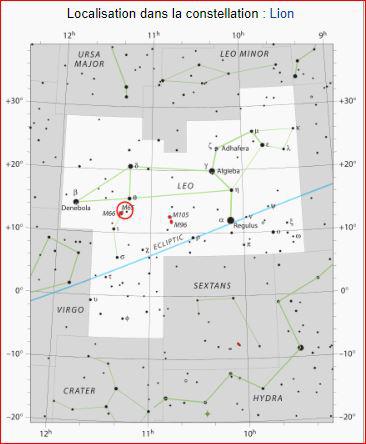| ACQUISITION | PARAMETRES ACQUISITION | |||||
| Objet | Filtres | Bin | Temps Pose | Nombres Poses | Temps Total | |
| Nom | Triplet du lion | Luminance | 1 x 1 | 5 mn | 27 | 135 mn |
| Constellation | Lion | Rouge | 1 x 1 | 5 mn | 12 | 60 mn |
| Distance | 35 millions al | Vert | 1 x 1 | 5 mn | 12 | 60 mn |
| Détail prise de vue | Bleu | 1 x 1 | 5 mn | 12 | 60 mn | |
| Lieu | Maison-Maugis 61 France | S2 | 1 x 1 | |||
| Date acquisition | 20/03 au 20/04/2018 | Hα | 1 x 1 | |||
| Setup | O3 | 1 x 1 | ||||
| Instrument | Newton Skyvision Mtn 250 | Totaux | 63 | 5 hrs 15 mn | ||
| Diamètre | 250 mm | Bias | 99 | |||
| Focale | 900 mm | Dark | 19 | |||
| Rapport F/D | 3,6 | Flat | 11 | |||
| Monture | EQ8 Skywatcher | Acquisition faite par | Francis Bozon | |||
| Caméra acquisition | Morovian G2 4000 | Traitement fait par | Francis Bozon | |||
| Caméra de guidage | Atik 314L | Logiciels utilisés | ||||
| Montage de guidage | DO Skymeca | Acquisition | TheSkyX – Software Bisque, Focusmax, Maxpilote | |||
| Echantillonage | 1,7 arcs | Traitement | Pixinsight, Photoshop | |||
COMMENTS ON THE OBJECT :
Nature of the galaxies of the Lion Trio:
The Lion Trio is a small cluster of interacting galaxies located about 35 million light years from Earth. Although not immediately obvious, all three are spiral galaxies like our Milky Way, because their disks are inclined at different angles to our line of sight.
Size of the image and the galaxies:
The width of the image represents an angular field of about 60 minutes, equivalent to twice the Full Moon.
Galaxies cover an average of only 12 x 3 arc minutes, which still represents, given their distances, 100,000 light years, a size equivalent to that of the Milky Way.
Position of the 3 galaxies:
On the left of the image, the almost vertical bar with a thin band of black dust represents galaxy NGC 3628, magnitude 9.5, as seen from the slice. It is also known as the “Hamburger Galaxy”.
Messier objects M 65 (NGC 3623), magnitude 9.3, below the upper right corner, and M 66 (NGC 3627), magnitude 8.9, left of the lower right corner, are tilted sufficiently for their spiral arms to be visible.
As for the stars in the image, such as the bright HIP 55262 at 155 light years, apparent magnitude 7.1 (near the upper edge), they all belong to our Milky Way .
Description of M 65 :
Although it is close to its neighbours, M65 looks like a “normal” spiral galaxy, and seems to have been little influenced by their gravitational field. It has a well-formed central lens and perfectly coiled spiral arms, plus a clear band of red ochre dust marking the edge facing us.
